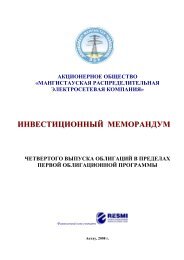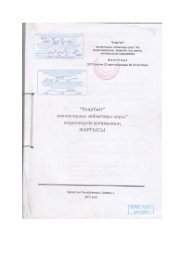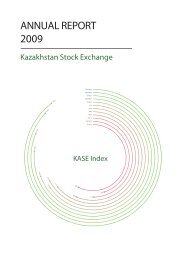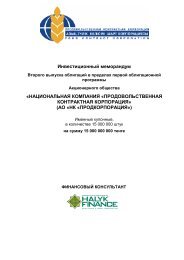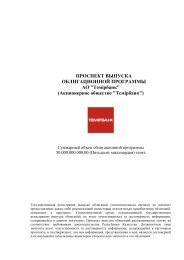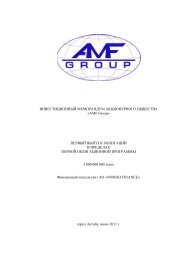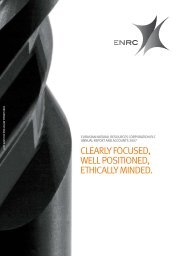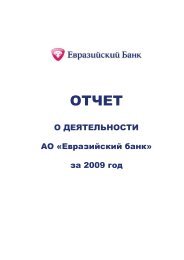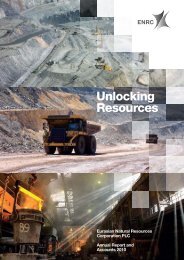JPMorgan - KASE
JPMorgan - KASE
JPMorgan - KASE
Create successful ePaper yourself
Turn your PDF publications into a flip-book with our unique Google optimized e-Paper software.
financial expenditure commitments. In the event a hydrocarbon contract cannot be negotiated, a<br />
producer runs the risk of losing all rights to its exploration and/or production licenses. In<br />
addition, the producer and a governmental design institute must formulate a development plan<br />
for each field specifying detailed drilling and production targets. The development plan may be<br />
periodically modified with the approval of the Kazakhstani government in order to reflect<br />
changing circumstances. Default by a producer under the terms of a license and related<br />
hydrocarbon contract or development plan can result in the loss of a production license and<br />
related hydrocarbon contract and, accordingly, all production rights.<br />
Hydrocarbon contracts for Kumkol South, Kumkol North, South Kumkol and the QAM fields have<br />
been negotiated and executed. The foundation agreement for Kazgermunai, as amended and<br />
supplemented, effectively serves as the hydrocarbon contract for the Akshabulak, Nurali and<br />
Aksai fields. The East Kumkol development program proceeds and the field will be operated<br />
jointly by HKM and Turgai Petroleum. Government approval of reserves has been obtained and<br />
production contract and license agreements are being negotiated.<br />
Royalties are payable quarterly or monthly, depending upon the particular hydrocarbon contract,<br />
to the Kazakhstani government in cash or in kind at the option of the Kazakhstani government.<br />
The following table sets forth the royalties for each of our fields:<br />
Name of Field<br />
Royalty<br />
Kumkol South (1) ...... —3%onfirst500,000 tons of cumulative annual production<br />
Akshabulak, Nurali and<br />
Aksaifields ..........<br />
— 6% on next 500,000 tons of cumulative annual production<br />
—10%onnext 500,000 tons of cumulative annual production<br />
— 15% on cumulative annual production in excess of 1.5 million tons<br />
Kumbol North (2) ...... —9%ofproduction<br />
South Kumkol (3) field . . — 10% of production, plus an excise tax of seven euros per ton for<br />
domestic crude oil sales<br />
Maybulak field ....... —3%onfirst350,000 tons of cumulative annual production plus an<br />
excise tax of two euros per ton for domestic crude oil sales<br />
— 4% on next 150,000 tons of cumulative annual production plus an<br />
excise tax of two euros per ton for domestic crude oil sales<br />
— 6% on cumulative annual production in excess of 500,000 tons plus<br />
an excise tax of two euros per ton for domestic crude oil sales<br />
Qyzylkiya field .......<br />
Aryskumfield ........<br />
—1.5%onfirst 1,600,000 tons of aggregate cumulative production<br />
from the date of the hydrocarbon contract<br />
— 2% on next 1,600,000 tons of aggregate cumulative production<br />
— 2.5% on aggregate cumulative production above 3,200,000 tons<br />
—1.5%onfirst 3,400,000 tons of aggregate cumulative production<br />
from the date of the hydrocarbon contract<br />
— 2% on next 3,400,000 tons of aggregate cumulative production<br />
— 2.5% on aggregate cumulative production above 6,800,000 tons<br />
(1) We paid a production bonus of $5,000,000 in 1999 and $5,000,000 in 2001 to the Kazakhstan government because we<br />
reached cumulative production of 5,000,000 and 10,000,000 tons of crude oil, respectively, from the Kumkol South field. A<br />
further production bonus payment of $5,000,000 will be required to be paid once cumulative production from the Kumkol<br />
South field reaches 15,000,000 tons of crude oil, which is anticipated during 2003.<br />
(2) Turgai Petroleum paid a production bonus of $500,000 in 1997 and $1,000,000 in 2001 to the Kazakhstan government<br />
because it reached cumulative production of 1,000,000 and 5,000,000 tons of crude oil, respectively, from the Kumkol North<br />
field. Further bonuses of $1,500,000 and $2,000,000 will be required to be paid once cumulative production from the Kumkol<br />
North field reaches 10,000,000, and 15,000,000 tons of crude oil, respectively, which are anticipated to occur during 2003 and<br />
2005.<br />
(3) We paid a production bonus of $500,000 in 2000 and $500,000 in 2002 to the Kazakhstan government because we reached<br />
cumulative production of 1,000,000 and 2,000,000 tons of crude oil, respectively, from the South Kumkol field. Further<br />
bonuses of $500,000 each will be required to be paid once cumulative production from the South Kumkol field reaches<br />
3,000,000 and 4,000,000 tons of crude oil, respectively, which is anticipated to occur during 2003.<br />
Royalties for North Nurali and East Kumkol are still to be negotiated in connection with<br />
obtaining hydrocarbon contracts and licenses.<br />
The hydrocarbon contracts that we entered into under our production licenses contain provisions<br />
for an excess profits tax. The tax rate is determined by the economic rate of return derived from<br />
the cash flows from operations in the contract area. The cash flow calculation takes into account<br />
the capital costs incurred in developing the field (in the case of HKM a portion of the purchase<br />
72




